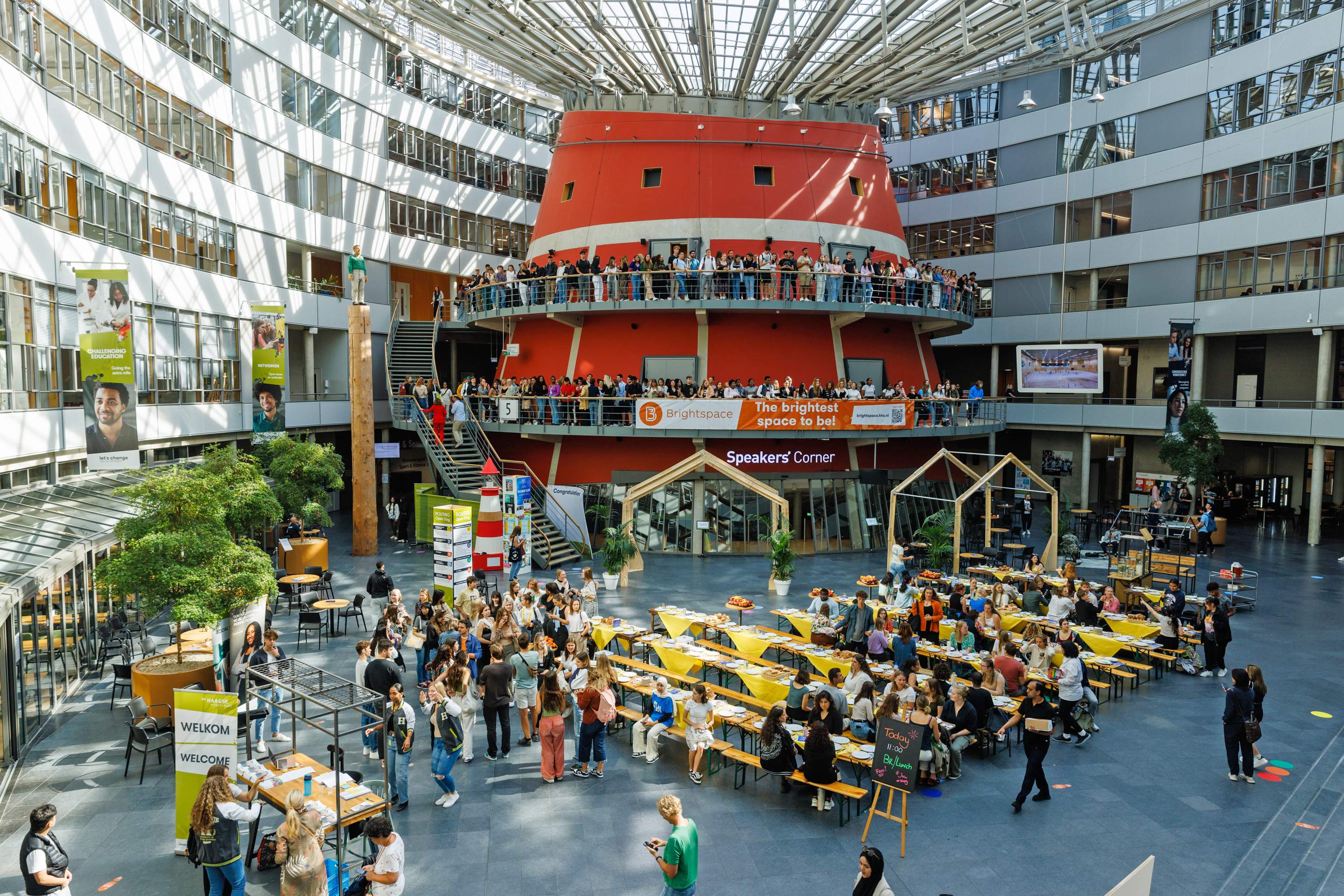📖Program Curriculum
Year 1
No, we’ll not bury you in books in this first year of User Experience Design. But, yes, you get a lot of introductory courses this year. In a very pleasant way. From day 1 you communicate with companies like Philips, IKEA and Google. You discuss with professionals, fellow students and lecturers how your ground-breaking ideas can change the way people use daily products.
Doing this you’ll get an understanding of how the user interacts with technology. You begin to fill your toolbox with the basics of communication, prototyping, persuasive experiences, technical designing and programming. You learn how to turn simple ideas into experiences across digital and physical platforms. You’ll programme your digital skills looking at web technologies, mobile platforms (Android and iOS), processing, Arduino and sensor technology.
Year 2
After your User Experience Design explorations in year 1, you’ll start digging deeper at the beginning of year 2. You’ll turn serious ideas into viable business plans. You’ll always pay close attention to end users’ technology habits. To make your technological designs a success, you have to understand the social systems at the core of your ideas. You will appreciate that tastes differ. That international tastes differ even more. The international classroom at UXD will show you how different cultures experience technology. You’ll learn how to cater for the world’s product needs.
In the first two modules of year 2, you take a minor programme, you go on an exchange or internship. And in the first half of year 3 you make an in-depth exploration of the complexities of UXD.
Internship
Your internship will be your first long-term introduction to practice. During your internship you use your knowledge, skills and attitude for example for giants like Capgemini, Intel, Apple or another company. Do an internship at one of the many great design agencies in the Randstad. Or at an IT company, a large insurer or bank. As a junior user experience designer you think about creating new concepts.
UXD is a global profession. So, why shouldn’t you use your toolbox in another country during your internship? In any case, you will discover which facets of user experience design appeal to you the most in practice. With that experience you can choose your minors or determine your graduation assignment.
You have almost finished your study. Just your graduation project. A challenge you take up without the help from your fellow students or lecturers in the second half of year 3. In the first half of this year you already have made an in-depth exploration of the complexities of UXD. This is really ‘all things UXD’! The graduation project gives you the opportunity to show which knowledge and skills you have collected in your toolbox during this three-years programme. After you have presented the results of your graduation project in a good effort you are ready to pack a punch in your new career as a digital pioneer.
Year 3
After your User Experience Design explorations in year 1, you’ll start digging deeper at the beginning of year 2. You’ll turn serious ideas into viable business plans. You’ll always pay close attention to end users’ technology habits. To make your technological designs a success, you have to understand the social systems at the core of your ideas. You will appreciate that tastes differ. That international tastes differ even more. The international classroom at UXD will show you how different cultures experience technology. You’ll learn how to cater for the world’s product needs.
In the first two modules of year 2, you take a minor programme, you go on an exchange or internship. And in the first half of year 3 you make an in-depth exploration of the complexities of UXD.
Internship
Your internship will be your first long-term introduction to practice. During your internship you use your knowledge, skills and attitude for example for giants like Capgemini, Intel, Apple or another company. Do an internship at one of the many great design agencies in the Randstad. Or at an IT company, a large insurer or bank. As a junior user experience designer you think about creating new concepts.
UXD is a global profession. So, why shouldn’t you use your toolbox in another country during your internship? In any case, you will discover which facets of user experience design appeal to you the most in practice. With that experience you can choose your minors or determine your graduation assignment.
Your graduation
You have almost finished your study. Just your graduation project. A challenge you take up without the help from your fellow students or lecturers in the second half of year 3. In the first half of this year you already have made an in-depth exploration of the complexities of UXD. This is really ‘all things UXD’! The graduation project gives you the opportunity to show which knowledge and skills you have collected in your toolbox during this three-years programme. After you have presented the results of your graduation project in a good effort you are ready to pack a punch in your new career as a digital pioneer.
Show less🏠 Accommodation
You will need to book the accommodation after you have been accepted.
You can choose to live on campus or off campus in private accommodation.
How to book:
- Make a booking online after you have been accepted (in this case please let us know your choice when you apply).
- Register when you arrive - its not possible to reserve a room before arriving. You can arrive a few days before and book it
💰 Fees
Application Fee:
$0 USD
Tuition fee:
9,889 EUR per year
29,667 EUR in total
❓✅❌ Entry Requirements
The minimum age is 18.
English fluency is required.
You need to be either:
- A native English speaker
- Studied a degree in English before
- Can demonstrate a high level of English
- Having an English certificate such as IELTS level 6 or TOEFL 95 and above is an advantage.
Minimum education level: High School.
The program is quite competitive, you need to have a high grades of Average B, 60%, or a high GPA.
All students from all countries are eligible to apply to this program.
Or see the list of programs you are eligible for here .
📬 Admissions Process
3 Steps to Apply to a University
Please choose the programs here , "You are advised to select 2-3 programs to increase your chances of getting accepted.
Required Documents:
- Personal Statement
Preparing documents:
You can start your application now and send the application documents during your application. Some documents you can send later if you don’t have them right away. Some more info about preparing application documents is here
Application process:
Applying Online is simple in just a few steps. More information is available here.
The first steps are to choose the programs, pay the application fee and upload the application documents.
Once submitted to Global Admissions, we will review your application within 2-3 days and proceed to the university or ask you for further clarification
After it has been processed to the university you will receive your unique application ID from each university.
The university may contact you directly for further questions.
We will then follow up each week with the university for updates. As soon as there is any update we will let you know. If you have made other plans, decide to withdraw / change address at any time please let us know.
After you have been accepted you will receive your admissions letter electronically and asked to pay the non-refundable deposit to the university.
Once you have paid the deposit the university will issue you the admissions letter and visa form to your home country.
Show less❓ Have a Question?
There are no similar questions. Please send us your question below

